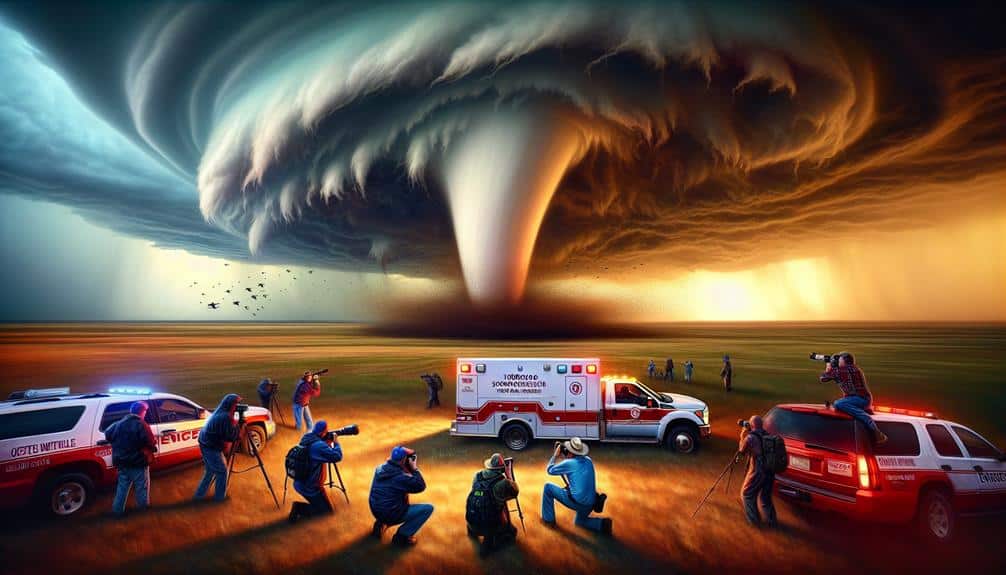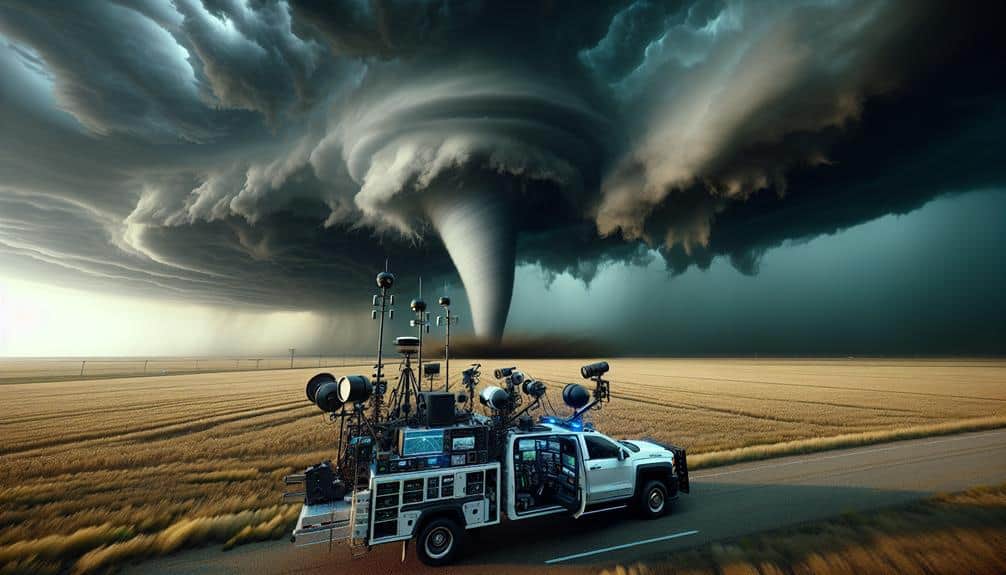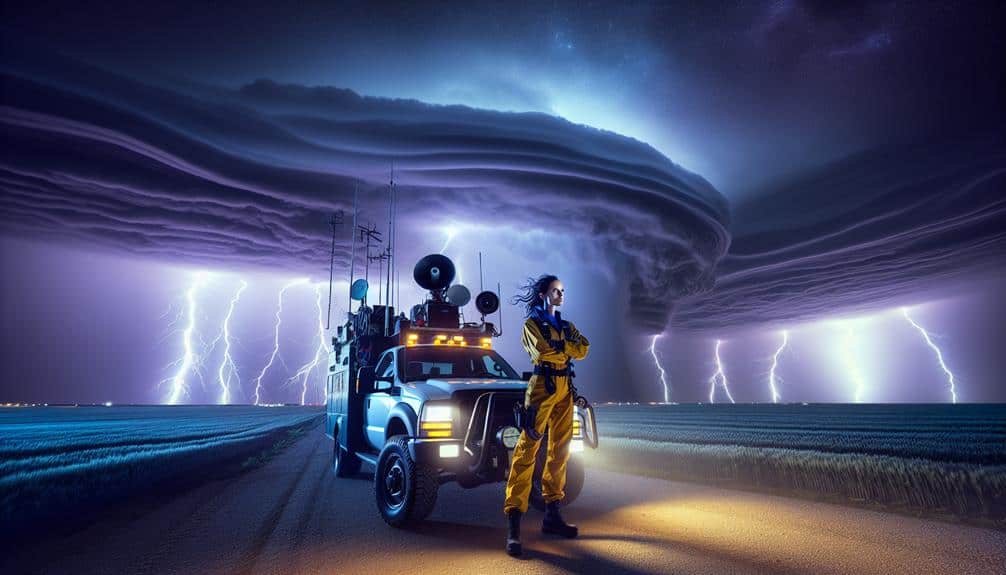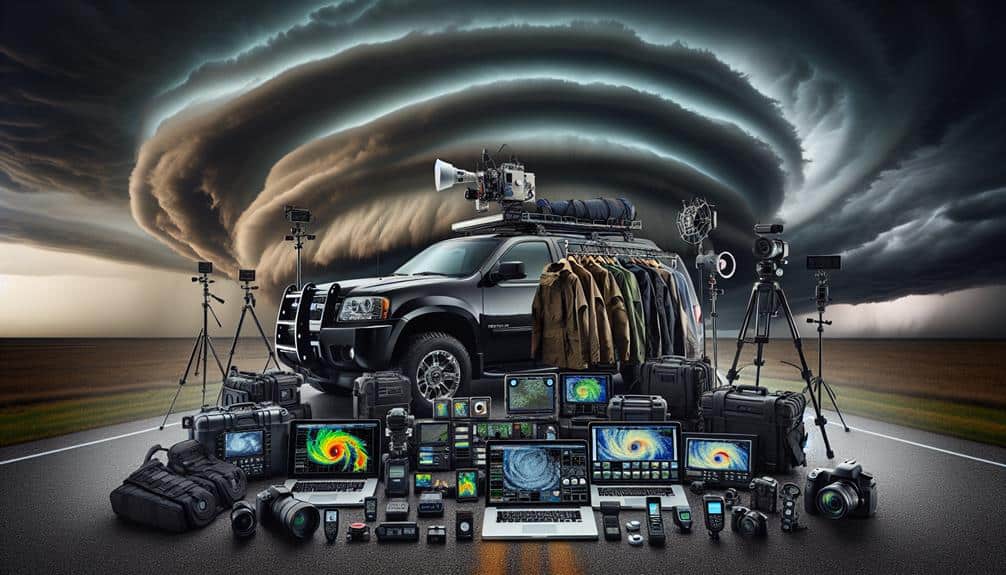In Tornado Alley, we need to address some common myths about storm chasing. It's not just reckless thrill-seekers; trained professionals use Doppler radar, GPS, and advanced safety protocols. Amateurs often underestimate severe risks and lack essential meteorological expertise. Tornadoes' behavior is unpredictable, and no equipment can guarantee complete safety. Legal and ethical issues also prevent unauthorized chasing. Despite the high operational costs, financial returns aren't guaranteed. Rigorous training, specialized gear, and precise data are essential for responsible storm chasing. Understanding these nuances gives us a clearer picture of the intricacies and realities involved.
Key Points
- Trained professionals use precise meteorological data and advanced safety protocols for safe storm chasing.
- Amateurs often lack the expertise and equipment necessary for safe storm chasing.
- Unauthorized storm chasing can result in severe legal consequences.
- High operational costs and unpredictable income make storm chasing financially unstable.
Storm Chasing Is Reckless
Contrary to popular belief, storm chasing isn't inherently reckless when conducted by trained professionals who rely on precise meteorological data and advanced safety protocols. As storm chasers, we engage in rigorous risk evaluation before heading out. We meticulously analyze weather models, radar data, and satellite imagery to pinpoint the storm's path. This allows us to position ourselves in safe locations that maximize visibility while minimizing danger.
We incorporate safety precautions at every step. Vehicles are equipped with GPS, communication devices, and weather monitoring tools to stay informed in real-time. Our teams undergo extensive training in meteorology and emergency response. Communication is key; we maintain constant contact through radios and mobile networks, ensuring everyone is aware of any sudden changes in the storm's behavior.
Only Experts Can Chase
While it's true that storm chasing requires expertise, we can't ignore the safety concerns for amateurs who lack proper training.
Essential equipment like Doppler radar, GPS, and communication tools are vital for mitigating risks.
Additionally, legal and ethical issues arise when inexperienced chasers put themselves and others in danger.
Safety Concerns for Amateurs
Many amateurs underestimate the severe risks involved in storm chasing, which requires specialized training and expertise to navigate safely. Without professional knowledge, the risks escalate exponentially, placing not only ourselves but also emergency responders in jeopardy.
Safety precautions and preparation are paramount. We need to understand meteorological data, grasp storm behavior, and be equipped to make split-second decisions.
Amateurs face significant limitations and risks:
- Lack of meteorological expertise: Storm chasing demands an in-depth understanding of weather patterns, which amateurs often lack. Misinterpreting data can lead us directly into hazardous situations.
- Inadequate safety precautions: Professionals employ thorough safety measures, such as escape routes and communication protocols. Amateurs, driven by thrill rather than preparation, often neglect these critical steps.
- Insufficient experience under pressure: Experts possess the ability to remain calm and make informed decisions amidst chaos. Amateurs may panic, leading to fatal mistakes.
The freedom to chase storms comes with the responsibility to do so safely. Without rigorous training and adherence to safety protocols, the excitement of storm chasing can quickly turn deadly. Let's respect the power of nature and the expertise required to engage with it responsibly.
Necessary Equipment and Gear
To effectively pursue storms, we must equip ourselves with specialized gear that guarantees both our safety and the accuracy of our data collection.
First and foremost, we need a reliable vehicle equipped with reinforced windows and a roll cage. Safety precautions demand that this vehicle be stocked with essential gear, such as weather radar systems, GPS units, and communication devices like radios and satellite phones. These tools enhance our weather awareness and secure we stay connected in areas with poor cellular reception.
Beyond technology, we must prioritize personal safety with items like helmets, protective clothing, and first aid kits. Emergency supplies are vital; our vehicle should always carry water, non-perishable food, and extra fuel. This preparation ensures we can handle unexpected situations, such as road closures or prolonged exposure to severe weather conditions.
Field data collection requires specialized instruments like anemometers, barometers, and high-resolution cameras. These devices allow us to capture precise atmospheric readings and visual evidence, which are essential for scientific analysis.
Legal and Ethical Issues
Equipped with the necessary gear, we must now address the legal and ethical boundaries that restrict storm chasing to trained experts. It's not merely a matter of thrill-seeking; the activity involves complex liability concerns and ethical dilemmas. Untrained individuals pose a significant risk to themselves and others, potentially leading to tragic outcomes.
Several critical factors underpin the necessity for expert-only storm chasing:
- Legal Ramifications: Unauthorized storm chasing can lead to severe legal consequences. Trespassing on private property, obstructing emergency services, and violating traffic laws are common infractions that can result in hefty fines or even imprisonment.
- Safety Protocols: Experts adhere to strict safety protocols designed to minimize risk. These include real-time weather data analysis, communication with emergency services, and pre-determined evacuation routes. Inexperienced chasers often lack this essential knowledge, compromising their safety and that of others.
- Liability Concerns: In the event of an accident, legal liability can be substantial. Insurance companies may refuse to cover damages incurred during unauthorized storm chasing, leaving individuals financially responsible for any harm caused.
Tornadoes Are Predictable

Contrary to popular belief, predicting tornadoes with absolute certainty remains a significant challenge for meteorologists. Despite advancements in forecasting accuracy, storm behavior is notoriously complex and difficult to predict. Tornadoes can form rapidly and in unexpected locations, making precise predictions elusive.
Although we've made significant strides in understanding the conditions that foster tornado development, pinpointing the exact time and place remains fraught with uncertainty.
Our current warning systems, while sophisticated, still have limitations. These systems rely on a combination of Doppler radar data, satellite imagery, and ground-based observations to issue alerts. While they've improved our ability to issue timely warnings, the lead time can vary. Sometimes, we only have minutes to respond.
This unpredictability necessitates robust emergency response plans, emphasizing the importance of readiness rather than reliance on precise forecasts.
Equipment Ensures Safety
While predicting tornadoes remains challenging, having the right equipment can greatly enhance our safety during storm-chasing expeditions. It's vital to arm ourselves with advanced technology and adhere to strict safety precautions.
Let's break down the essential gear we need:
- Mobile Doppler Radar: This tool provides real-time data on storm structure and rotation, allowing us to track tornado development with precision. By detecting wind velocities, we can anticipate the storm's path and adjust our position accordingly.
- GPS and Mapping Software: Accurate navigation is important. High-resolution maps integrated with GPS help us avoid hazardous areas and find the safest routes. These tools are necessary when visibility drops, and roads become difficult to navigate.
- Communication Devices: Reliable communication keeps us connected with other storm chasers and emergency services. Satellite phones, two-way radios, and weather apps make sure we receive timely updates and can call for help if needed.
Storm Chasing Is Illegal

Many people believe storm chasing is illegal, but this is a common misconception. In reality, storm chasing isn't prohibited by any specific federal or state law. However, it's essential to understand that while the act itself isn't illegal, there are regulations we must follow to guarantee safety and order. Law enforcement agencies are primarily concerned with maintaining public safety and keeping roads clear for emergency responders.
Public perception often conflates the legality of storm chasing with the reckless behavior sometimes exhibited by a small minority of chasers. Most of us adhere to strict ethical guidelines and cooperate with law enforcement to avoid obstructing traffic or emergency operations.
Data from the National Oceanic and Atmospheric Administration (NOAA) highlight that the majority of storm chasers operate legally and responsibly.
Moreover, storm chasers contribute valuable data to meteorological research, enhancing our understanding of severe weather patterns. We rely on accurate GPS coordinates, real-time data sharing, and communication with local authorities to minimize risks.
Storm Chasing Is Profitable
When we consider storm chasing as a profitable venture, we must account for high operational expenses such as fuel, equipment, and vehicle maintenance.
Income sources are unpredictable, often relying on selling footage or data to media outlets, which doesn't guarantee consistent revenue.
Despite the thrill, storm chasing rarely yields a stable financial return due to these economic uncertainties.
High Operational Expenses
Despite the common belief that storm chasing is profitable, the reality is that high operational costs often outweigh potential profits. We face numerous financial risks and budget constraints that greatly impact our bottom line. These costs can be broken down into several key areas:
- Equipment Costs: High-quality radar systems, GPS units, and cameras are essential for effective storm chasing, but they come with substantial price tags. Maintenance and upgrades add to these expenses.
- Travel Expenses: Chasing storms requires constant mobility. Fuel, lodging, and food costs accumulate rapidly, especially during active storm seasons.
- Insurance and Safety Gear: Given the inherent dangers of storm chasing, comprehensive insurance and specialized safety gear (like reinforced vehicles) are non-negotiable necessities. These add another layer of financial burden.
Our operational expenses aren't only significant but also necessary to mitigate the risks associated with storm chasing. Each decision we make must balance these financial risks with the potential for scientific discovery or media sales.
With strict budget constraints, even minor financial missteps can result in noteworthy setbacks. Therefore, while the allure of storm chasing is undeniable, we must acknowledge the economic realities that come with pursuing these powerful tempests.
Unpredictable Income Sources
Our income sources are notoriously unpredictable, making it challenging to depend on storm chasing as a stable financial venture. The inherent variability in weather patterns means we can't ensure consistent footage or data sales. Some months, we might capture dramatic tornado footage that sells well to media outlets, while other times, our efforts yield little financial return. This results in unstable finances, where our earnings can fluctuate drastically.
Moreover, the costs associated with storm chasing, such as vehicle maintenance, fuel, and advanced meteorological equipment, often outweigh the sporadic income. It's a high-risk, high-reward scenario that doesn't always pay off. We invest in cutting-edge technology to track storms accurately, but these risky investments don't guarantee a steady stream of revenue.
Data from the National Weather Service indicates that severe weather events aren't evenly distributed throughout the year, further complicating our financial planning. While the thrill of the chase and the potential for groundbreaking footage are undeniable, we must acknowledge that storm chasing is far from a reliable source of income.
For those of us driven by a passion for meteorology and freedom, the financial instability remains a significant, yet accepted, part of the journey.
Frequently Asked Questions
How Do Storm Chasers Stay Informed About Weather Conditions in Real-Time?
We stay informed about weather conditions in real-time by utilizing weather apps and receiving emergency alerts. These tools provide us with precise, up-to-date meteorological data, enabling us to make swift, informed decisions and maintain our freedom of movement.
What Should One Do if They Encounter a Tornado While Driving?
When we encounter a tornado while driving, safety precautions and response strategies are essential. We should identify emergency shelter options or clear escape routes immediately. Avoid overpasses and seek a sturdy building or low-lying area for safety.
Are There Specific Seasons When Tornadoes Are More Frequent in Tornado Alley?
Yes, tornado alley seasons exhibit distinct frequency patterns. Peak tornado occurrences happen in late spring and early summer, primarily from April to June. These months show increased instability and wind shear, essential for tornado formation.
How Do Storm Chasers Communicate and Coordinate With Each Other During a Chase?
We use advanced technology and adhere to strict safety protocols to communicate and coordinate during a chase. Real-time data from radar, GPS, and mobile apps guarantee accurate positioning and efficient teamwork, keeping us informed and safe.
What Are the Environmental Impacts of Storm Chasing Activities?
When we chase storms, our presence can ripple through the environment, causing wildlife disturbance and soil erosion. We must balance our thirst for knowledge with respect for nature's delicate tapestry, using data-driven strategies to minimize our impact.


